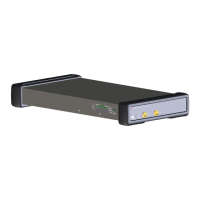Keysight N778xC Series Polarization Instruments User’s Guide 61
User Interface Reference 4
Polarization Controller Basics
This section describes the basic operation of the polarization controller
functions of the N778xC instruments.
The operation of the LiNbO3 polarization controller (PC) integrated with
most instruments of the N778xC series family is comparable to a cascade
of six endlessly rotatable waveplates:
The state of the PC is given by the position of the waveplates which is
expressed in terms of six angles ϕ0...ϕ5 measured in degree (ranging from
0..360. Due to the internal structure of the PC the waveplates are endlessly
rotatable, i.e. there will be a continuous polarization state transition when
increasing the position beyond 360, which is similar to starting from 0
again.
Note that the retardation may slightly differ from the nominal values
depending on the operating wavelength and temperature. Furthermore,
there may be a systematic deviation due to the electro-optic properties of
the LiNbO3 polarization controller. Usually these deviations are not an
issue since in most applications the polarization is adjusted in an adaptive
way (like for manual fiber-loop polarization controllers).
Loop Synchronous Operation in Optical Loop Test Beds
In scramble mode and sequence mode the instrument can be
synchronized to external events to support synchronous operation to
optical loop test beds. Two configurations are recommended:
No Loop Clock - Internal Timebase
In this configuration the N778xC is synchronized to the beginning of the
loop sequence when the fiber loop is loaded with the optical burst data. It
then processes the look-up table (either generated for scrambling or
loaded from a file) using an internal clock timer. The loop cycle time
depends on the length of the fiber loop. You have to find the clock rate and
the phase of the PC manually to match the switching times with the loop
cycles.

